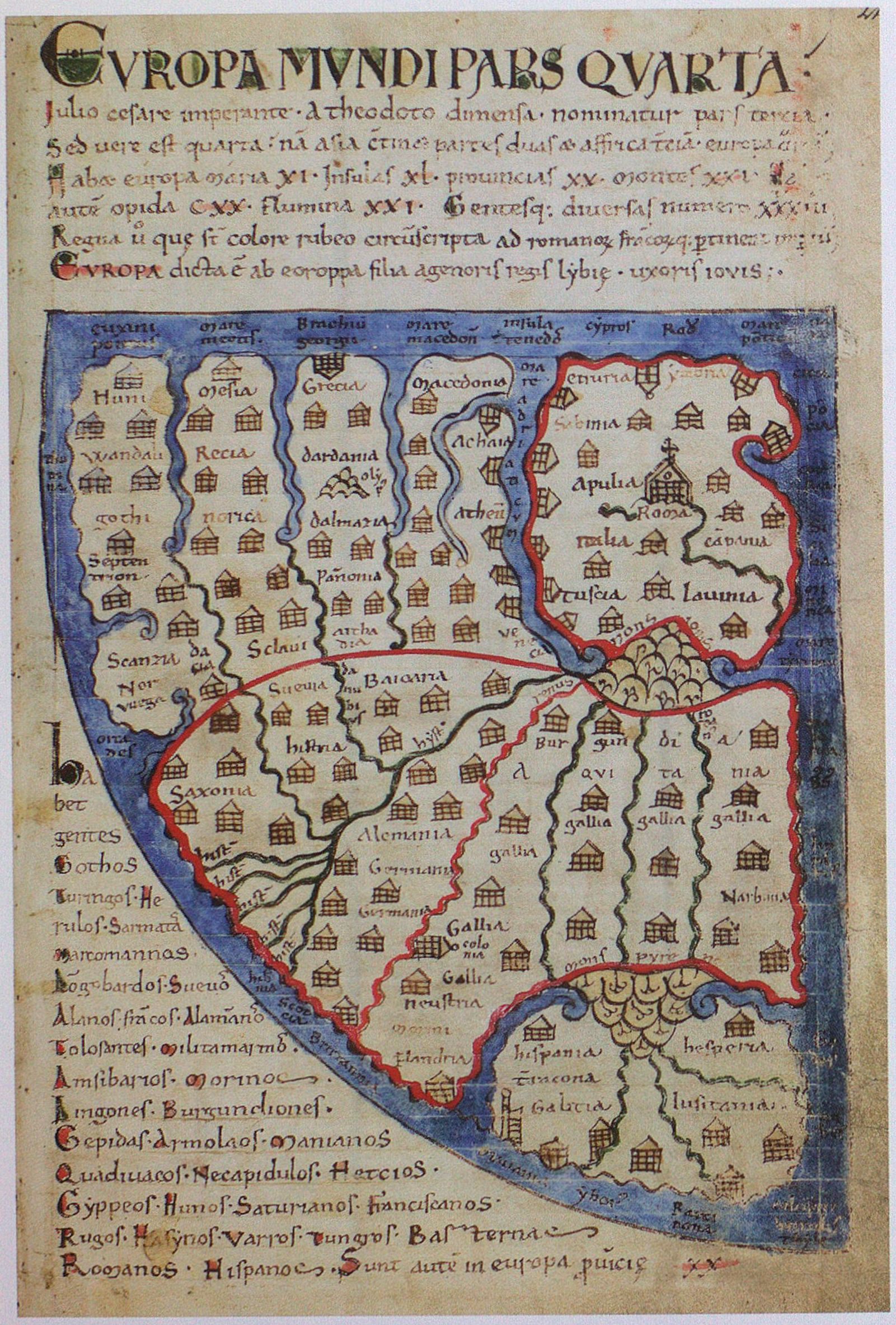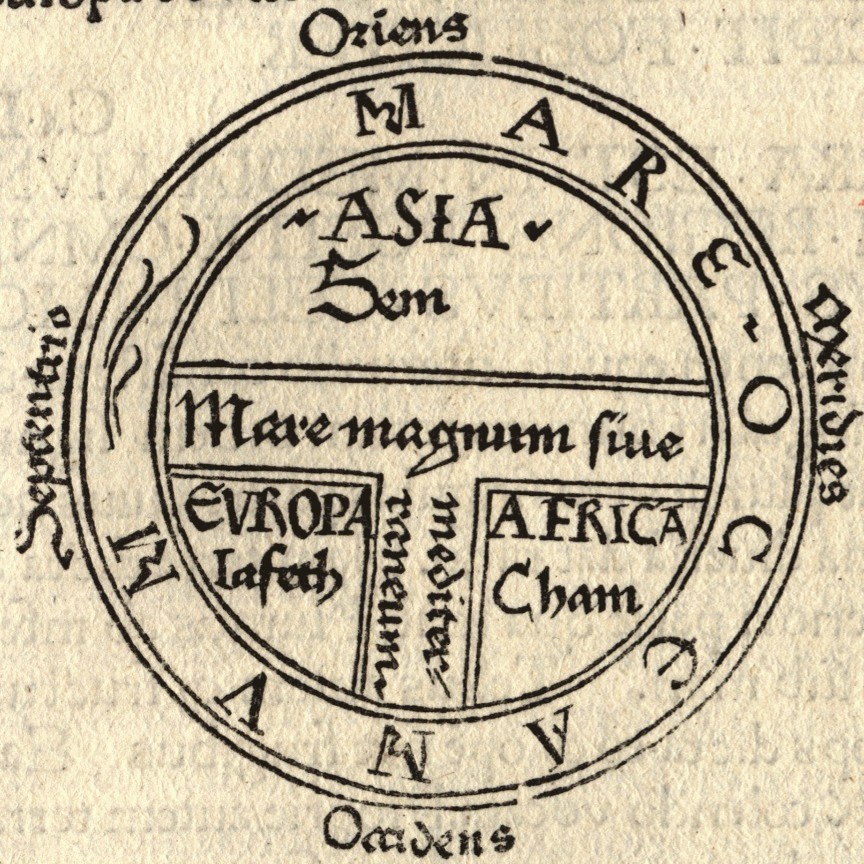Europe
One of three continents in the world (the others being Africa and Asia). Europe is thought to make up one-quarter of the world.
Map of Europe from the Liber Floridus (11th/12th century):
Ecosystem
Europe shows a number of different biogeographical zones. These definitions are based on those of the EU Natura 2000 project. See the climate map. Note that these zones are modern definitions - they were not categorised in the medieval period, though the differences between them were noted by travellers.
Alpine Zone
The mountain ranges of the Apennines, Yrenees, Scandes, Carpathians and the Alps themselves are chgaracteristd by high altitudes, complex topography and a harsh, cold environment. The mountains show a series of compressed habitat zones. Forests and grasslands dominate the lower slopes, but temperature drops as altitude rises, and trees give way to alpine grasslands, fells and heaths. The treeline varies with latitude - around 3,200 feet (1,000m) in the Pyrenees; around 3,500 feet (2,000m) in the Scandes. The high peaks are dominated by snowfields, glaciers and a handful of plants adapted to extreme conditions. The complex topography of the mountains creates many different microclimates, depending on exposure or shelter from sun and wind. The mountaisn are a haven for large carnivores, such as wolf, bear and lynx, and raptors such as eagles, falcons and vultures.Arctic Zone
The Arctic regions of the far north - including Iceland and northern part sof Scandinavia and Russia - contain a range of landscapes, including bare rock, swamp, glaciers, meadows, mountains and lowland plains. Permafrost prevents water penetrating the ground in the tundra, maining soils are perpetually waterlogged and boggy during summer rains. The cycles of thawing and freezing cause intense erosion, creating numerous microcliimate pockets. Within the Arctic Circle the midnight sun can be seen at the hieght of summer, and winter is perpetual gloom.Anatolian Zone
The Anatolian plateau is characteristed by low rainfall and large differences in summer and winter temperatures - above 30oC (85oF) in high summer, and as low as -15oC (5oF) in winter. Much of the area is steppe, with extensive salt steppes in the central plateau amd Igdir Plain. Tree cover is low - only 4% of total area - with woodlands mainly in the lower slopes of eastern mountains. Decidious oakwwoods occur in the north, with the transition zone to the Black Sea region dominated by pines. Wetlands - dominated by soda and volacanic lakes surrounded byt reeds and marshes - are fed by small streams.Atlantic Zone
The Atlantic region is a moderate maritime climate, with westerly winds bringing frequent, year-round rain from the Atlantic, cooling summer temperatures and warming winters. Wave erosion makes the coastline varied, from rocky cliffs to sandy beaches, and the Gulf Steam makes the seas and shorelines rich in marine life. A combination of glacial activity during the last Ice Age and human exploitation has reduced biodiversity on land - in the Middle Ages assarting converts woods and marshes into arable land; the mild climate creeates a long growing season. Most of Europe's heathlands occur in the Atlantic zone - some natural, others the result of overfarming in prehistory.Black Sea Zone
Humid air currents moderate the continental weather along the coast of the deep, tideless Black Sea, warming winters and cooling summers. The zone is incredibly rich in wildlife, boostyed twice a year when migrating birds pass through the region. Much of the coastline is dominated by beaches and low dunes , with occasioinal cliffs and headlands. Beyond the shoreline are a series of coastal lakes, marshes and lagoons. The largest wetlands are those of the Danube Delta, which hosts very diverse wildlife. Low hills in the wetlands are frequently wooded.Boreal Zone
The much of north-eastern Scandinavia and the Baltic lands are a mosaic of forests and lakes. Woods dominated cover more than 60% of the land surface, predominantly spruce and pines in the the taiga. In the far north peatlands make up half of the land surface in places. Coastal areas and a thousands of islands in a series of archipelagos form low-lying habitats for waders, waterfowl and seabirds.Continental Zone
A broad band stretching eastwards from central France to the Ural Mountains. The Continental Zome is characterised by cold winters and hot summers, a contrast which becomes more pronounced the further eastwards one travels. Much of the zone was home to primeval beech, oak and hornbeam woods, though many have been cleared for agriculture. Wetlands, grasslands and meadows are also common. In the intermediate areas of the south and east the zone shares characteristics of the Alpine and Atlantic zones. The Continental zone is a crossroad between other zones and is rich in species, many of which recolonised the areas from the south and east after the last Ice Age.Mediterranean Zone
The Mediterranean regions are characerised by hoy, dry summers and humid, cool winters. Weather is capricious, however, and high winds blow at various times of the year. The Sirocco, which occurs mainly in summer, is a cyclone ortiginating in the Sahara which blows over the Mediterranean Sea to southern Europe bringing warm, wet weather, in some areas known as 'blood rain' due to the high sand content. The Mistral, most common in winter or spring, is a strong, cold northwesterly that blows from southern France to the Gulf of Lion. Both winds can reach hurricane speeds. The landscape is a mix of the characteristic scrubland, mountains hills and rocky shores, coastal wetlands and beeches. Woodlands are diverse - while northern forests may be dominated by a dozen tree species, Mediterranean woods may harbour 100 different species. Some arid areas, too dry for trees, are covered with dense grasslands. The sea itself is a fertile habitat for marine life. The region has been a centre for human activity for millennia. The zone extends across the Mediterranean into the Maghreb and coastal Levant.Pannonian Zone
A large, alluvial Hungarian plain, once an ancient inland sea, ringed by hills and mountains makes up the Pannonian region. The surrounding uplands shelter the region, with wet westerly winds tempered by warm Mediterreanean winds and cool temperatures from the Alps and Carpathians. The region's weather is complex, and subject to occasional violent thunderstorms. The region was once made up of warm forests and forest steppes, but has ancient grazing has turned it into a huge grassland - one of the oldest man-made habitats in Europe - watered by tributaries of the Danube and Tisza. The plain's fertile loess soils are rich in sand, silt and minerals, and easilyt scattered by the wind. Combined with the complex weather, this creates a mosaic of habitats around the grass plains, including sand dunes, sandy steppes and maple-oak forests. Caves and underground rivers are common in the karst limestone landscape in the foothills of the Carpathians. The region has very high species diversity, boosted by migrating geese, ducks and waders which flock to the shallow wetlands every year.Steppic Zone
The zone, characterised by bitterly cold winters and warm, dry summers, stretches from the extreme east of Europe into Central Asia. Temperatures can range from less than -15oC (5oF) in winter to more than 30oC (85oF) in summer, with hot summer winds that can cause dramatic temperature differences within a day. Droughts are common and can last for months, and trees are absent from the landscape except along rivers and stream, near wetlands, or on the western fringes where the steppes marge into the Mediterranean zone; waterways and wetlands provide diversity of flora and fauna in a landscape dominated by grasslands made up of high grasses such as couch grass, feather grass and fescue, and herbaceous plants including cinquefoil, mullein and wormwood.Maps
-
European Climate Zones
Europe's primary biogeographical zones, showing the northern limit of vine cultivation in late antiquity, the olive-growing regions, and areas of fertile loess soils. Sources:
1:10m Natural Earth II datasets from Natural Earth
EU Natura 2000 datasets (2016 edition)
Chorological data for the main European woody speciesfrom Figshare
Geodata of European loess domains from the Collaborative Research Centre 806
Donald Matthew, Atlas of Medieval Europe (Equinox, Oxford, 1983)






Comments